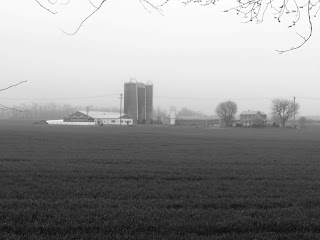 Seeing large numbers of anything
is impressive. In a time in which much of the ecosystem is imperiled, observing
an extraordinarily large number of snow geese wintering in rural Pennsylvania
offers hope for the future of birds and animals. Nature is resilient, yet the lake
at the Middle
Creek Management Area, along the borders of Lancaster and Lebanon counties,
were created when a dam was built in the 1970. The geese, which once used the
east coast as navigation, have moved further inland as development has reduced feeding
areas. The phenomenon of extraordinary numbers of birds gathering in central Pennsylvania
is a reaction to human pursuits.
Seeing large numbers of anything
is impressive. In a time in which much of the ecosystem is imperiled, observing
an extraordinarily large number of snow geese wintering in rural Pennsylvania
offers hope for the future of birds and animals. Nature is resilient, yet the lake
at the Middle
Creek Management Area, along the borders of Lancaster and Lebanon counties,
were created when a dam was built in the 1970. The geese, which once used the
east coast as navigation, have moved further inland as development has reduced feeding
areas. The phenomenon of extraordinary numbers of birds gathering in central Pennsylvania
is a reaction to human pursuits.  |
| Tundra Swans |
In February the snow geese and tundra
swans, as well as numerous humans, congregate at the wildlife management area near
the small village of Stevens. People who have not walked any distance in quite
some time, trudge a three-quarter mile path to see more than 100,000 snow geese
occupying the reservoir. Slightly dwarfed by the showcase geese, families of
tundra swan that nest in Alaska and northern Canada, gather and rest for a few
days of rest on other parts of the reservoir lake. Although there are far more
geese, the number of swans can reach an impressive 10,000 birds at a time.
 The close proximity to so many birds
is humbling. It is almost as if the geese are nearly tame, yet they are not
exactly ready to cozy up to people. Even
a small toddler, rambunctious and reckless as he is, gets remarkably close to
the geese scouring the grass. The geese are not easily spooked but mosey off if
humans (or dogs) venture too close.
The close proximity to so many birds
is humbling. It is almost as if the geese are nearly tame, yet they are not
exactly ready to cozy up to people. Even
a small toddler, rambunctious and reckless as he is, gets remarkably close to
the geese scouring the grass. The geese are not easily spooked but mosey off if
humans (or dogs) venture too close.
What photographs, and even
videos, cannot capture is the sound of a multitude of birds simultaneously
calling. Even from across the lake, the sound ebbs and flows, like a wave that
alerts us to the presence of nature. Watching the intricate motions of collective
of geese, much like a murmuration of starlings, is compelling. Are eyes deceive
us to pay attention to the whole, while missing the actions of the individual.






















